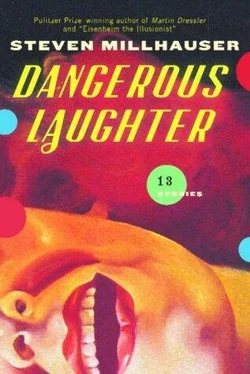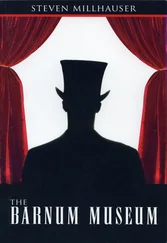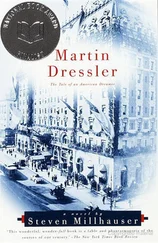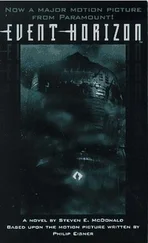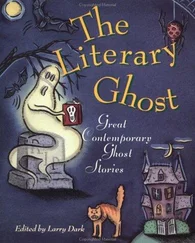It is unclear exactly what happened next. Someone appears to have exclaimed. Curtis, turning back to the painting, became aware of a motion or “agitation” in the canvas. As he watched, standing about a foot from the picture, the paintings in the studio began to fade away. Those that hung on the wall and those that stood in stacks on the floor grew paler and paler, the painting on the easel and the photographs on the table began to fade, and Crane himself, with his palette and brush, seemed to be turning into a ghost.
Soon nothing was left in the painting but a cluttered studio hung with white canvases, framed and unframed. Blank canvases were stacked six deep against the walls. The mouse’s tail, Curtis says, showed distinctly against the whiteness of the empty canvas.
“What the devil!” someone cried. Curtis turned around. In the real room, Crane himself was no longer there.
The door, Curtis noticed, was partly open. He and two of his friends immediately left the rented office and took a four-wheeler to Crane’s studio. There they found the door unlocked. Inside, everything was exactly as in the painting: the easel with its blank canvas, the empty rectangles on the walls, the table with its scattering of blank printing paper, the stacks of white canvases standing about, even the ashes on the windowsill. When Curtis looked more closely, he had the uneasy sensation that a mouse’s tail had just darted out of sight behind a canvas. Curtis felt he had stepped into a painting. It struck him that Crane had anticipated this moment, and he had an odd impulse to tip his hat to his old friend. It may have been the pale November light, or the “premonition of dread” that came over him then, but he was suddenly seized by a sense of insubstantiality, as if at any moment he might begin to fade away. With a backward glance, like a man pursued, he fled the empty studio.
Crane was never seen again. Not a single painting or sketch has survived. At best we can clumsily resurrect them through careless newspaper accounts and the descriptions, at times detailed, in the diary of W. C. Curtis. Of his other work, nothing remains except some eighty engravings in the pages of contemporary magazines — mediocre woodblock reproductions in no way different from the hurried hackwork of the time. Based on this work alone — his visible oeuvre — Harlan Crane deserves no more than a footnote in the history of late-nineteenth-century American magazine illustration. It is his vanished work that lays claim to our attention.
He teases us, this man who is neither one thing nor another, who swerves away from the history of painting in the direction of the cinema, while creating a lost medium that has no name. If I call him a precursor, it is because he is part of the broad impulse in the last quarter of the nineteenth century to make pictures move — to enact for mass audiences, through modern technology, an ancient mystery. In this sense it is tempting to think of him as a figure who looks both ways: toward the future, when the inventions of Edison and the Lumières will soon be born, and toward the remote past, when paintings were ambiguously alive, in a half-forgotten world of magic and dream. But finally it would be a mistake to abandon him here, in a shadow-place between a vanished world and a world not yet come into being. Rather, his work represents a turn, a dislocation, a bold error, a venture into a possible future that somehow failed to take place. One might say that history, in the person of Harlan Crane, had a wayward and forbidden thought. And if, after all, that unborn future should one day burst forth? Then Harlan Crane might prove to be a precursor in a more exact sense. For even now there are signs of boredom with the old illusions of cinema, a longing for new astonishments. In research laboratories in universities across the country, in film studios in New York and California, we hear of radical advances in multidimensional imaging, of mobile vivigrams, of a modern cinema that banishes the old-fashioned screen in order to permit audiences to mingle freely with brilliantly realistic illusions. The time may be near when the image will be released from its ancient bondage to cave wall and frame and screen, and a new race of beings will walk the earth. On that day the history of the cinema will have to be rewritten, and Harlan Crane will take his place as a prophet. For us, in the meantime, he must remain what he was to his contemporaries: a twilight man, a riddle. If we have summoned him here from the perfection of his self-erasure, it is because his lost work draws us toward unfamiliar and alluring realms, where history seems to hesitate for a moment, in order to contemplate an alternative, before striding on.
The diary of W. C. Curtis, published in 1898, makes one last reference to Harlan Crane. In the summer of 1896 Curtis, traveling in Vienna, visited the Kunsthistorisches Museum, where a still life (by A. Muntz) reminded him of his old friend. “The pipe was so like his,” Curtis writes, “that it cast me back to the days of our old friendship.” But rather than devoting a single sentence to the days of his old friendship, Curtis describes the painting instead: the stained meerschaum bowl, the cherrywood stem, the black rubber bit, even the tarnished brass ring at the upper end of the bowl, which we hear about for the first time. The pipe rests on its side, next to a pewter-lidded beer stein decorated with the figure of a hunting dog in relief. Bits of ash, fallen from the bowl, lie scattered on the plain wooden tabletop. In the bowl glows a small ember. A thin curl of smoke rises over the rim.
THE WIZARD OF WEST ORANGE
OCTOBER 14, 1889. BUT THE WIZARD’Son fire! The Wizard is wild! He sleeps for two hours and works for twelve, sleeps for three hours and works for nineteen. The cot in the library, the cot in Room 12. Hair falling on forehead, vest open, tie askew. He bounds up the stairs, strides from room to room, greeting the experimenters, asking questions, cracking a joke. His boyish smile, his sharp eye. Why that way? Why not this? Notebook open, a furious sketch. Another. On to the next room! Hurls himself into a score of projects, concentrating with fanatical attention on each one before dismissing it to fling himself into next. The automatic adjustment for the recording stylus of the perfected phonograph. The speaking doll. Instantly grasps the essential problem, makes a decisive suggestion. Improved machinery for drawing brass wire. The aurophone, for enhancement of hearing. His trip to Paris has charged him with energy. Out into the courtyard! — the electrical lab, the chemical lab. Dangers of high-voltage alternating current: tests for safety. Improved insulation for electrical conductors. On to the metallurgical lab, to examine the graders and crushers, the belt conveyors, the ore samples. His magnetic ore-separator. “Work like hell, boys!” In Photographic Building, an air of secrecy. Excitement over the new Eastman film, the long strip in which lies the secret of visual motion. The Wizard says kinetoscope will do for the eye what phonograph does for the ear. But not yet, not yet! The men talk. What else? What next? A method of producing electricity directly from coal? A machine for compacting snow to clear city streets? Artificial silk? He hasn’t slept at home for a week. They say the Wizard goes down to the Box, the experimental room in basement. Always kept locked. Rumors swirl. Another big invention to rival the phonograph? Surpass the incandescent lamp? The Wizard reads in library in the early mornings. From my desk in alcove I see him turn pages impatiently. Sometimes he thrusts at me a list of books to order. Warburton’s Physiology of Animals. Greene and Wilson, Cutaneous Sensation. Makes a note, slams book shut, strides out. Earnshaw says Wizard spent three hours shut up in the Box last night.
Читать дальше
